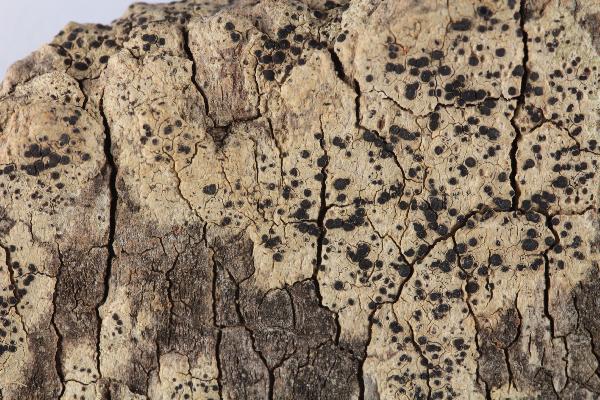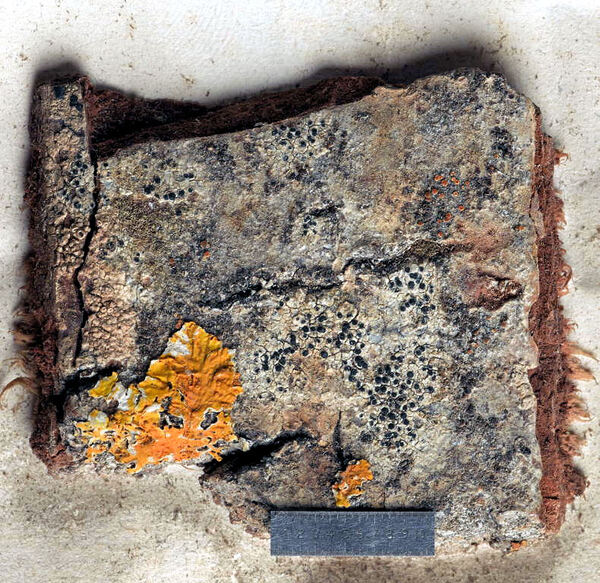Diplotomma populorum A. Massal.
Ric. Auton. Lich. Crost.: 99, 1852.
Synonyms: Buellia alboatra var. populorum (A. Massal.) H. Olivier; Buellia caricae (Bagl.) Lettau; Buellia populorum (A. Massal.) Clauzade & Cl. Roux; Diplotomma caricae (Bagl.) Jatta
Distribution: N - VG, Frl, Ven (Lazzarin 2000b), Piem, Emil (Fariselli & al. 2020), Lig. C - Tosc, Marc (Nimis & Tretiach 1999), Laz, Sar. S - Camp (Aprile & al. 2003b), Bas, Pugl, Cal (Puntillo 1996), Si.
Description: Thallus crustose, episubstratic, areolate, white to grey-white, sometimes delimited by a black prothallus. Upper cortex pseudoparenchymatous, with minute crystals not soluble in K; medulla white, I-. Apothecia lecideine, 0.2-0.3 mm across, at first immersed, then emergent, adnate, without a spurious thalline margin; disc black, sometimes white-pruinose, at first flat then convex; proper margin thin, finally excluded. Epithecium brown; hymenium colourless, not inspersed with oil droplets, K/I+ blue; paraphyses simple with enlarged, pigmented apical cells; hypothecium brown. Asci 8-spored, clavate to cylindrical-clavate, the apical dome K/I+ dark blue with a pale, conical-pointed apical cushion (axial mass), the wall I-, but the thin outer gel I+ blue, approaching the Bacidia-type. Ascospores 3-septate, brown, with rounded lumina, very thick-walled, not ornamented, often curved, 13-18 x 8-11 µm. Photobiont chlorococcoid. Spot tests: thallus K-, C-, KC-, P-, UV-. Chemistry: without lichen substances. Note: a mild-temperate lichen found on isolated trees with eutrophic or eutrophicated bark, usually at relatively low elevations. The relationship with D. alboatrum needs to be clarified.
Growth form: Crustose
Substrata: bark
Photobiont: green algae other than Trentepohlia
Reproductive strategy: mainly sexual
Commonnes-rarity: (info)
Alpine belt: absent
Subalpine belt: absent
Oromediterranean belt: absent
Montane belt: extremely rare
Submediterranean belt: rare
Padanian area: very rare
Humid submediterranean belt: rare
Humid mediterranean belt: rare
Dry mediterranean belt: very rare

Predictive model
Herbarium samples

Collezione lichenologica Abramo Massalongo del Museo di Storia Naturale G. Ligabue di Venezia - Autori: Seggi, Linda; Trabucco, Raffaella Proprietà: Fondazione Musei Civici di Venezia - CC BY-NC
Italy, Veneto, in op. Parona
as var. effusum

Collezione lichenologica Abramo Massalongo del Museo di Storia Naturale G. Ligabue di Venezia - Autori: Seggi, Linda; Trabucco, Raffaella Proprietà: Fondazione Musei Civici di Venezia - CC BY-NC
Italy, Veneto, in op. S. Martino 1855

Collezione lichenologica Abramo Massalongo del Museo di Storia Naturale G. Ligabue di Venezia - Autori: Seggi, Linda; Trabucco, Raffaella Proprietà: Fondazione Musei Civici di Venezia - CC BY-NC
Italy, Veneto, ad populos

The Trustees of the Natural History Museum, London – CC BY-SA 4.0 Source: http://data.nhm.ac.uk/dataset/56e711e6-c847-4f99-915a-6894bb5c5dea/resource/05ff2255-c38a-40c9-b657-4ccb55ab2feb?view_id=6ba121d1-da26-4ee1-81fa-7da11e68f68e&filters=subDepartment%3ALichens%7CgbifIssue%3ATAXON_MATCH_HIGHERRANK%7Cfamily%3Acaliciaceae
Growth form: Crustose
Substrata: bark
Photobiont: green algae other than Trentepohlia
Reproductive strategy: mainly sexual
Commonnes-rarity: (info)
Alpine belt: absent
Subalpine belt: absent
Oromediterranean belt: absent
Montane belt: extremely rare
Submediterranean belt: rare
Padanian area: very rare
Humid submediterranean belt: rare
Humid mediterranean belt: rare
Dry mediterranean belt: very rare

Predictive model
| Herbarium samples |

Collezione lichenologica Abramo Massalongo del Museo di Storia Naturale G. Ligabue di Venezia - Autori: Seggi, Linda; Trabucco, Raffaella Proprietà: Fondazione Musei Civici di Venezia - CC BY-NC
Italy, Veneto, in op. Parona
as var. effusum

Collezione lichenologica Abramo Massalongo del Museo di Storia Naturale G. Ligabue di Venezia - Autori: Seggi, Linda; Trabucco, Raffaella Proprietà: Fondazione Musei Civici di Venezia - CC BY-NC
Italy, Veneto, in op. S. Martino 1855

Collezione lichenologica Abramo Massalongo del Museo di Storia Naturale G. Ligabue di Venezia - Autori: Seggi, Linda; Trabucco, Raffaella Proprietà: Fondazione Musei Civici di Venezia - CC BY-NC
Italy, Veneto, ad populos

 INDEX FUNGORUM
INDEX FUNGORUM
 GBIF
GBIF
 DOLICHENS
DOLICHENS

